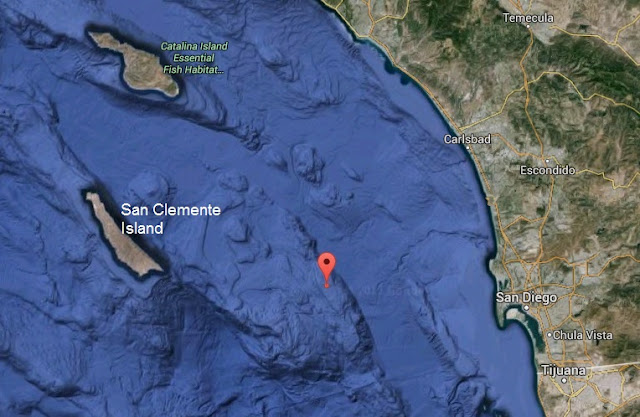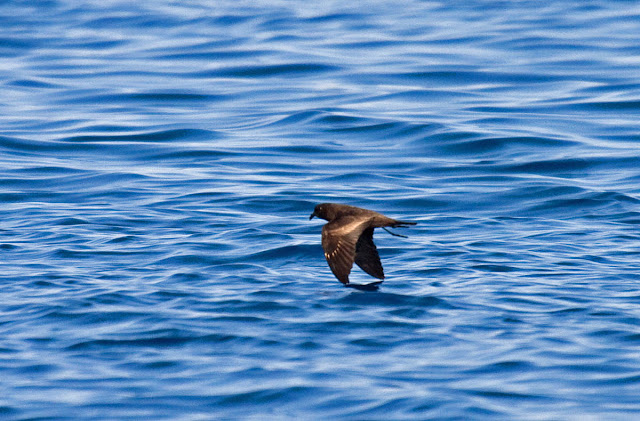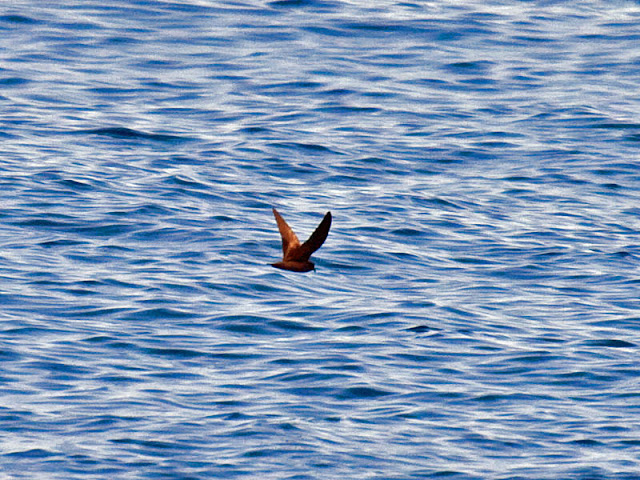Storm-petrels are tiny little seabirds. They flit across the waves staying far away from land where they may fall prey to larger gulls. They search for food--crustaceans barely larger than microscopic that float along the ocean's currents. These they pick off the ocean's surface while hovering. While many storm-petrels are solitary, some form dense flocks.
Most storm-petrels breed on isolated islands, digging their nest burrows under sod. To avoid predators they only come ashore at night. No bright colors or distinctive patterns are necessary to attract mates in such situations--most species are black or brown, some with pale bellies. Already hard to identify because they look similar, they also tend to flee away from boats, and are hard to observe.
 |
| Location of storm-petrel flock west of San Diego |
About 30 miles west of La Jolla an autumn flock of storm-petrels gather each year. Those bird watchers who keep track of birds by county find a slight vexation with the storm-petrel flock. You see, the seabird watching trip departs from San Diego and spends all its time in San Diego County waters. However, the storm-petrel flock is often just a mile closer to San Clemente Island (Los Angeles County) than to La Jolla (San Diego County). Thus, according to the "nearest point of land" rule, these storm-petrels are frustratingly in Los Angeles County and much less frequent in San Diego County waters. Silly, I know, even to many birders. But, for instance, I've seen 311 bird species in San Diego County and only 76 avian species in Los Angeles County. These San Diego pelagic trips often venture across the imaginary line into Los Angeles County to find the storm-petrel flock.
 |
| There's the flock! About 3000 birds. |
We can only approach to within about 500 feet before the birds pick up and fly away to resettle a bit farther off. So we approach as near as we dare and wait for individuals to fly closer. We see that about 20% of the flock is made of the larger Black Storm-Petrels, the rest are the much smaller Least Storm-Petrels.
 |
| Black Storm-Petrels |
Besides being larger and blacker, Black Storm-Petrels fly with leisurely deep wing strokes (they remind me of Black Terns in flight). Photos show wings raised and lowered quite far. They also show a longer wing held forward at the wrist and an obvious pale carpal bar (wrist and upper arm) on the upper wing. The tail is forked and fairly long.
 |
| Black Storm-Petrel. 30 miles East of San Clemente Island, Los Angeles Co., California. October 11, 2015. Greg Gillson. |
The small Least Storm-Petrels are paler brown. The wings are shorter, straighter and flapped deeply but quickly and stiffly ("bat-like"). They almost appear tailless.
 |
| Least Storm-Petrel. 30 miles East of San Clemente Island, Los Angeles Co., California. October 11, 2015. Greg Gillson. |
We kept a lookout for other species, especially any with white rumps (Leach's Storm-Petrels and rare Wilson's Storm-Petrels) but we saw none. One grayish Ashy Storm-Petrel was spotted by a couple of people as it flew with rapid shallow wing strokes in a straight line but twisty side-to-side flight, very long tail, and whitish under wing linings. But I missed it this time among the swarm.






No comments:
Post a Comment
I really want to hear from you! I've changed settings (again) in order to try to make commenting easier without opening it up to spammers. Please note, however, that comments to posts older than 14 days will be moderated. Thank you.